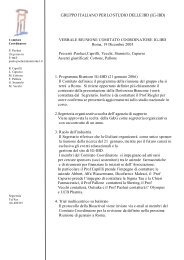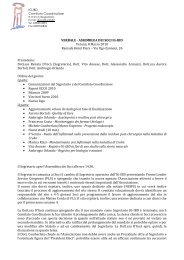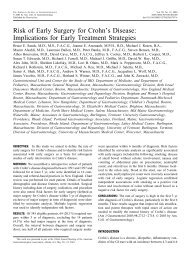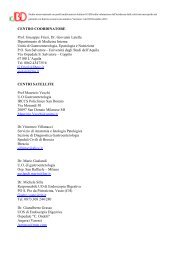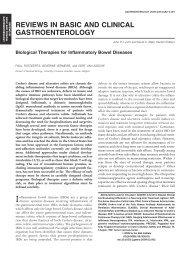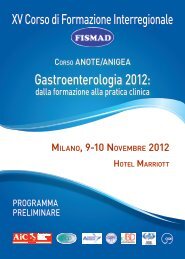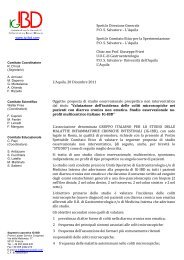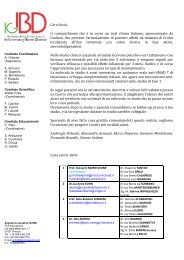marc lémann,* jean–yves mary,‡ bernard duclos,§ michel - IG-IBD
marc lémann,* jean–yves mary,‡ bernard duclos,§ michel - IG-IBD
marc lémann,* jean–yves mary,‡ bernard duclos,§ michel - IG-IBD
Create successful ePaper yourself
Turn your PDF publications into a flip-book with our unique Google optimized e-Paper software.
1056 LEMANN ET AL GASTROENTEROLOGY Vol. 130, No. 4<br />
Data Collection<br />
A complete medical history and current medications<br />
were recorded at study inclusion. Physical examination and<br />
laboratory tests (C-reactive protein, erythrocyte sedimentation<br />
rate, blood counts, liver tests) were performed at screening and<br />
at each visit (weeks 0, 2, 6, 12, 24, and 52). The CDAI, 10 a<br />
steroid side-effect score, and the cumulative doses of steroids<br />
also were calculated at each visit. A chest radiograph and<br />
tuberculin test were performed at inclusion and at week 24. A<br />
colonoscopy was performed, if the patient agreed, at baseline<br />
and at week 24, and the Crohn’s Disease Endoscopic Index of<br />
Severity (CDEIS) was calculated. 11 Adverse events were recorded<br />
at each visit and were classified as mild, moderate, or<br />
severe; the relationship to study medications also was evaluated.<br />
The CDAI10 was calculated by using patient reports of<br />
symptoms on diary cards within the week preceding each visit.<br />
The CDEIS was assessed according to the presence and the<br />
extent of lesions and ulcerations (deep or superficial), and<br />
according to the presence of ulcerated and nonulcerated strictures<br />
on the 5 following segments: rectum, sigmoid and left<br />
colon, transverse colon, right colon, and ileum. 11 The steroid<br />
side-effects score was calculated as follows: 1 point was attributed<br />
for each minor to moderate side effect including acne,<br />
swelling of the face, buffalo hump, striae, moderate increase in<br />
abdominal fat, insomnia or minor psychic disturbances, and<br />
other minor side effects; and 2 points for each severe side effect<br />
including amyotrophy and/or muscular weakness, pronounced<br />
cushingoid obesity, severe acne, diabetes mellitus, cataract,<br />
symptomatic bone complications, severe psychic disturbances,<br />
high blood pressure, or other severe side effects; the score could<br />
vary from 0 to 16.<br />
End Points<br />
All pri<strong>mary</strong> and secondary end points were prespecified.<br />
The pri<strong>mary</strong> efficacy end point was the rate of success,<br />
defined as a clinical remission (CDAI 150) 12 off steroids at<br />
week 24. Secondary efficacy end points were as follows: (1)<br />
success rate at week 12, (2) rate of steroid resistance, (3)<br />
cumulative dose of prednisone at week 24, (4) steroids sideeffect<br />
score at weeks 6, 12, and 24, (5) endoscopic improvement<br />
between inclusion and week 24, and (6) adverse events.<br />
A follow-up evaluation also was planned at week 52, with<br />
assessment of the success rate. During the follow-up period<br />
(weeks 24–52), all treatments could be given as necessary;<br />
patients who had a relapse or received additional infusions of<br />
infliximab were classified as treatment failures.<br />
Statistical Analysis<br />
The sample size calculation was based on the assumption<br />
that infliximab would be better than placebo (1-sided<br />
basis). We estimated that 128 patients were needed to detect<br />
a crude difference of 20% for the pri<strong>mary</strong> end point between<br />
placebo and infliximab, assuming a remission rate of 60% with<br />
the placebo, with a power of 80%. The analysis of efficacy was<br />
performed according to the intent-to-treat principle. All pa-<br />
tients enrolled and not lost to follow-up evaluation were<br />
included in the efficacy analysis, except if the CDAI was<br />
missing. The analysis of safety was conducted including all<br />
patients who had received at least 1 infusion of study medication.<br />
Categoric variables were described using frequencies and<br />
percentages and their distributions were compared between<br />
treatment groups, globally, and per stratum by using the 2<br />
test or the Fisher exact test. Continuous variables were summarized<br />
using the frequency, median, and interquartile range<br />
and their distributions were compared between treatment<br />
groups using the Mann–Whitney test.<br />
Success rates (the pri<strong>mary</strong> end point) were compared using<br />
the 2 test (globally and per stratum); the multiple logistic<br />
regression method also was used to estimate the odds ratio<br />
(OR) of success with 95% confidence intervals (CIs) and to test<br />
if the efficacy of infliximab compared with placebo was different<br />
across strata (interaction between treatment and stratum).<br />
Success at 12 or 52 weeks and steroid resistance were analyzed<br />
similar to the pri<strong>mary</strong> end point. The cumulative dose of<br />
prednisone, steroid side-effect score, and decrease in the CDEIS<br />
were analyzed using the Mann–Whitney test.<br />
Multivariate logistic regression analysis, adjusted on treatment<br />
and stratum, with backward selection using the likelihood<br />
ratio test, was used to look for factors measured at<br />
baseline that were independently predictive of success at week<br />
24. Variables were proposed to this analysis if the P value was<br />
less than .30 in the univariate analysis. Continuous factors<br />
were categorized as follows: each variable first was divided into<br />
4 categories at approximately the 25th, 50th, and 75th percentiles.<br />
If the ORs of adjacent categories were not statistically<br />
different, these categories were grouped. If no clear pattern was<br />
observed, the median was taken as a cut-off point. Usual<br />
limits, such as 150 for the CDAI, also were tested. The<br />
treatment effect and treatment-strata interaction were tested<br />
after adjustment on independent prognostic factors. Results<br />
were expressed as ORs with 95% CIs.<br />
Results were considered significant when the P value was<br />
less than .05. Data were analyzed with SPSS Software for<br />
Windows, release 6.1 (SPSS Inc, Chicago, IL).<br />
Results<br />
Baseline Characteristics of Patients<br />
The trial profile is shown in Figure 1. A total of<br />
115 patients were randomized (56 in the failure stratum/59<br />
in the naive stratum); 57 patients (26 in the<br />
failure stratum) were assigned randomly to receive infliximab<br />
and 58 patients (30 in the failure stratum) to<br />
receive placebo. Two patients allocated to placebo treatment<br />
(1 in each stratum) were not enrolled and did not<br />
receive the first infusion, 1 patient because his CDAI was<br />
less than 150 at inclusion and the other patient because<br />
he withdrew his consent before the inclusion visit.




